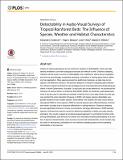Files in this item
Detectability in audio-visual surveys of tropical rainforest birds : the influence of species, weather and habitat characteristics
Item metadata
| dc.contributor.author | Anderson, Alexander S. | |
| dc.contributor.author | Marques, Tiago A. | |
| dc.contributor.author | Shoo, Luke P. | |
| dc.contributor.author | Williams, Stephen E. | |
| dc.date.accessioned | 2015-08-07T11:10:02Z | |
| dc.date.available | 2015-08-07T11:10:02Z | |
| dc.date.issued | 2015-06-25 | |
| dc.identifier | 207996216 | |
| dc.identifier | 648d4413-2e54-44fb-acaf-4764bdde4c27 | |
| dc.identifier | 000356933800010 | |
| dc.identifier | 84938372965 | |
| dc.identifier | 000356933800010 | |
| dc.identifier.citation | Anderson , A S , Marques , T A , Shoo , L P & Williams , S E 2015 , ' Detectability in audio-visual surveys of tropical rainforest birds : the influence of species, weather and habitat characteristics ' , PLoS One , vol. 10 , no. 6 , 0128464 . https://doi.org/10.1371/journal.pone.0128464 | en |
| dc.identifier.issn | 1932-6203 | |
| dc.identifier.other | ORCID: /0000-0002-2581-1972/work/56861298 | |
| dc.identifier.uri | https://hdl.handle.net/10023/7147 | |
| dc.description | This research was funded by the Australian Government’s National Environmental Research Program, the Stuart Leslie Bird Research Award from Birds Australia (http://www.birdsaustralia.com.au/), the Earthwatch Institute (http://www.earthwatch.org/australia/), the Marine and Tropical Sciences Research Facility (MTSRF: http://www.rrrc.org.au/mtsrf). In addition, TAM was partially sponsored by national funds through the Fundação Nacional para a Ciência e Tecnologia, Portugal – FCT under the project (PEst-OE/MAT/UI0006/2011). Date of Acceptance: 27/04/2015 | en |
| dc.description.abstract | Indices of relative abundance do not control for variation in detectability, which can bias density estimates such that ecological processes are difficult to infer. Distance sampling methods can be used to correct for detectability, but in rainforest, where dense vegetation and diverse assemblages complicate sampling, information is lacking about factors affecting their application. Rare species present an additional challenge, as data may be too sparse to fit detection functions. We present analyses of distance sampling data collected for a diverse tropical rainforest bird assemblage across broad elevational and latitudinal gradients in North Queensland, Australia. Using audio and visual detections, we assessed the influence of various factors on Effective Strip Width (ESW), an intuitively useful parameter, since it can be used to calculate an estimate of density from count data. Body size and species exerted the most important influence on ESW, with larger species detectable over greater distances than smaller species. Secondarily, wet weather and high shrub density decreased ESW for most species. ESW for several species also differed between summer and winter, possibly due to seasonal differences in calling behavior. Distance sampling proved logistically intensive in these environments, but large differences in ESW between species confirmed the need to correct for detection probability to obtain accurate density estimates. Our results suggest an evidence-based approach to controlling for factors influencing detectability, and avenues for further work including modeling detectability as a function of species characteristics such as body size and call characteristics. Such models may be useful in developing a calibration for non-distance sampling data and for estimating detectability of rare species. | |
| dc.format.extent | 24 | |
| dc.format.extent | 2358300 | |
| dc.language.iso | eng | |
| dc.relation.ispartof | PLoS One | en |
| dc.subject | Distance-sampling methods | en |
| dc.subject | Australian wet tropics | en |
| dc.subject | Point-count surveys | en |
| dc.subject | Climate-change | en |
| dc.subject | Population-size | en |
| dc.subject | Transect counts | en |
| dc.subject | Measurement error | en |
| dc.subject | Breeding season | en |
| dc.subject | Abundance | en |
| dc.subject | Density | en |
| dc.subject | HA Statistics | en |
| dc.subject | QL Zoology | en |
| dc.subject | NDAS | en |
| dc.subject | SDG 13 - Climate Action | en |
| dc.subject.lcc | HA | en |
| dc.subject.lcc | QL | en |
| dc.title | Detectability in audio-visual surveys of tropical rainforest birds : the influence of species, weather and habitat characteristics | en |
| dc.type | Journal article | en |
| dc.contributor.institution | University of St Andrews. School of Mathematics and Statistics | en |
| dc.contributor.institution | University of St Andrews. Scottish Oceans Institute | en |
| dc.contributor.institution | University of St Andrews. Centre for Research into Ecological & Environmental Modelling | en |
| dc.identifier.doi | 10.1371/journal.pone.0128464 | |
| dc.description.status | Peer reviewed | en |
This item appears in the following Collection(s)
Items in the St Andrews Research Repository are protected by copyright, with all rights reserved, unless otherwise indicated.

